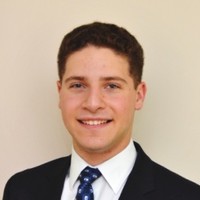
"The best thing that educators could do to make students interested in STEM is show that the STEM areas involve creativity. They allow the student to explore. They’re not these static areas ... There’s room for students to make their own contributions."
Before Joshua Lederman was a freshman at Cornell University in the College of Engineering, planning to major in Applied Engineering Physics, he benefited from the KnowAtom science curriculum while in elementary school. His experience in the STEM disciplines gives him a unique perspective on the impact of a good STEM education.
Now, at Cornell, he is a member of CUAUV, a Cornell project team which designs and builds an autonomous underwater vehicle to compete in the International RoboSub Competition. The following is a transcript of a conversation between Josh and KnowAtom CEO Francis Vigeant.
In this Paths to Innovation conversation, Francis and Josh discuss:
- The different roles on the CUAUV team and Josh's work with the team
- How higher-order thinking translates to college
- The traditional and next generation model from a student's perspective
Francis Vigeant: Thank you for joining us for this look at the Path to STEM Innovation. I’m Francis Vigeant, CEO here at KnowAtom. To introduce you to KnowAtom and what KnowAtom is, we are an organization focused on higher order thinking, specifically critical thinking skills, the skills to create, evaluate, and analyze the way a scientist or engineer would. In order to do that, we think that science and engineering, or STEM (Science, Technology, Engineering, and Math), is really the best context to teach those skills to children from Kindergarten through grade 12, not so that every child will graduate and be a scientist or engineer, but so that they’ll be well equipped for any college or career of their choice.
With that in mind, we help educators and school districts to be able to transform their classroom into a place where students can actually be scientists and engineers, learn hands-on and engage in the practices of science and engineering. That way, if they choose to pursue sales or marketing, go to college or even pursue a terminal degree in science or engineering, they are ready with the skills to be trainable for whatever future they choose. As part of that, we like to engage in professional development, and this particular session about the Path to Innovation is one of those professional development series.
I’d like to introduce our special guest today, Joshua Lederman. Josh is an undergraduate student in Engineering Physics at the College of Engineering at Cornell. We’re especially excited to have Josh here with us today because he represents the first generation of KnowAtom Elementary School students to have reached college age. We’re encouraged to know that he’s found a passion in STEM and is pursuing an engineering degree at Cornell, specifically, Engineering Physics. Welcome, Josh.
Joshua Lederman: It’s great to be here.
Vigeant: We appreciate you joining us. Thinking about Kindergarten through 12th Grade and now to Undergraduate Engineering, I wanted to bring up this diagram to clue our audience into the relationship between science, knowledge, engineering, and technology, especially as it exists today with the next generation science standards. That science is considered knowledge from experimentation that scientists ask questions and they actually expose the underlying theories that, I guess, govern our world. Engineers use that knowledge to solve problems by prototyping and testing technology, which then gets scaled up to help us all improve our lives, math being at the center of it all, helping us communicate. I wanted to get your thoughts first and foremost about why you chose engineering in the first place, Josh.
Lederman: I would say, I chose engineering because I always … From a very young age, I liked to understand how stuff worked. I liked to learn how people have done stuff before to design my own things, even if using the kits you learned with, just in magnetism, simple circuits, that was … At a young age, and I’ve always enjoyed that. I decided to pursue basically a very in-depth understanding of how stuff works in engineering at Cornell.
Vigeant: As you were transitioning through elementary, middle school, and then high school, you did graduate valedictorian of your class, why did you choose Cornell of all colleges of engineering? Was there something special that stood out?
Lederman: First and foremost, Cornell has a great engineering program, but I really liked it because of the opportunities I saw there, both in terms of the academic quality and also the ability to apply the type of things I’m learning, in either research or, as we’re going to talk about, in project teams where you can actually build things using what you’re learning in class.
Vigeant: It sounds like the program you’re a part of really brings this relationship between science and engineering, the knowledge and the technology piece together in an applied way. I noticed that Cornell talks about breaking the rules to encourage independent thinking. What does that mean to you in the context of your program?
Lederman: I would say that it means to me that to come up with, do things in ways you haven’t done before. To come up with new ways of achieving a task which don’t conform to the expectations or the practices you might have learned about in classes or in the typical way of doing things. Often the best way of fixing a problem is something that has been done before and that it will … You have to think outside the box. You have to think of new ways to do things in order to innovate and come up with devices that can solve problems.
Vigeant: Thinking about that focus, how does … Can you explain a little bit about your major? You’re studying Engineering Physics, which basically sounds to me like taking that knowledge and somehow turning it into technology. How does that work? What is that major about?
Lederman: Engineering Physics is a combination a theoretical understanding of physics and applying that theoretical understanding. You have to have a broad understanding of the concepts of physics, various, the physical laws, but also the major focuses on how you can use those laws. For example, nanoscience involves combination of aspects from electricity and magnetism, material science, even mechanical engineering, and it’s the … in order to understand those things, you have to have a broad understanding of physical phenomena and that I think is what Engineering Physics is all about.
Vigeant: Even outside of your degree and your program classes, you’ve elected to take it a step further and Cornell’s one of those unique places, I think, that when most people think of undergraduate college experience, they think about joining sports teams like football, baseball, lacrosse, maybe swimming and so on. Top engineering schools like Cornell’s have made sport of team research and problem solving competitions. One of those is the Cornell University Autonomous Underwater Vehicle team, CUAUV, which you’re a part of. Can you explain a little bit about how this maybe takes some of your major focus to the next level and how research is a competition here at the university level through CUAUV?
Lederman: Yeah, I see CUAUV as a bunch of people working together in order to create a project by the end of the year. Instead of traditional team sports, where you’re focused towards the next competition, the next … You’re competing with other teams throughout the year. I feel that CUAUV, the whole year is focused toward one objective where we are constantly thinking of ways of accomplishing that objective.
You have a bunch of different people, each one who’s working on some component of the project, so that everything then combined to produce something that is, I guess, more than sum of its parts, something that can, I guess, compete at the end of the year. Something that’s an innovation, it’s a new device that is different from anything that’s come before.
Vigeant: I see. In comparing CUAUV, with a traditional college team competition like baseball or something, do you have perhaps, instead of just the championship at end of the year like we might think of with football or baseball, something like that, do you have perhaps milestones within the year, smaller competitions or testing … Anything like that that goes on on a more local level?
Lederman: Yeah, there definitely is a structure where, a schedule where each step throughout the year, we start out with more electronic designs using design software. Then it goes through printing for electrical team, which I’m on. It’s printing circuit boards, then we go in to test the circuit boards. Then we get integrated into the new sub. It all builds up throughout the year toward the competition in a way that I feel doesn’t really work for traditional teams, where it doesn’t really work that way and I really like that aspect of CUAUV.
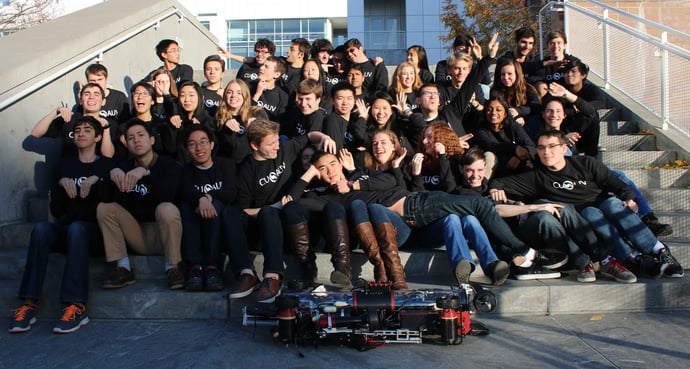
Vigeant: Oh, that’s great. Just taking a look at this, this is the CUAUV team, this year’s team. I wanted to take a closer look though at what you’re actually creating. An autonomous underwater vehicle is a robot and, correct me if I’m wrong, it’s a robot that nobody is … It’s not tethered to anyone. You’re not controlling it by remote. It has to operate on its own autonomously. Can you take us through what these robots are supposed to do and how that competition’s structured at high level?
Lederman: The competition occurs once every year at the end of July. Basically, every year the team creates a new robot for the competition and the robot tends to improve on last year’s robot and it is always a new design. You can see from the image there are three different devices along upside of the robot.
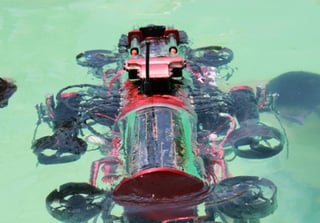
You see the thrusters to move it around, sensors such as the cameras toward the right side which allow it to get input from the surroundings and also actuators. You see a clock in the center as well as a funnel toward the right, which allow it to interact with the tasks. There are something like five tasks every year which the robot is designed around. They involve visual recognition, manipulation of objects, shooting torpedoes, and other things that a typical underwater vehicle would have to do in, for example, a more applicable surrounding such as underwater exploration.
The robot basically, has to do everything autonomously. It has to figure out where it is, interact with surroundings and accomplish the objectives without any human input, which involves a lot of advanced software within the robot.
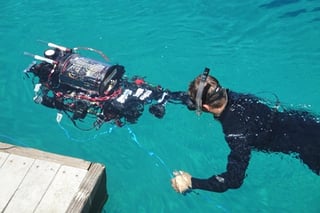
I have a few picture actually from the competition that I believe occurs in San Diego. Could you tell us a little bit about that? Here’s the robot being dropped into the water here.
Yeah, you could see the swimmer on the right is actually not a member of CUAUV. She is a member who works for the competition, because we are not allowed to have any contact with the robot after it’s put in. The swimmer starts the robot then they follow it around, usually taking video and watching as it tries to accomplish the objectives. You can see, it looks very impressive underwater. I think we have some pictures, some of the tasks. Here you see, claws have to pick up … These objects, actually, it has to recognize which are actually made out of K’nex and moving them around.
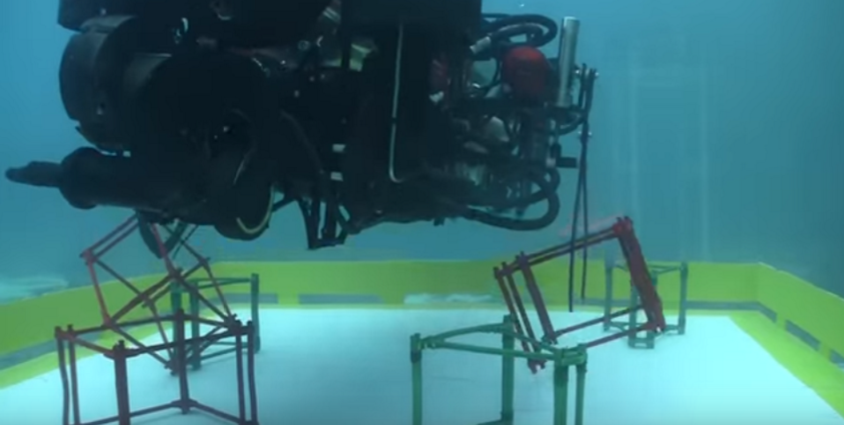
Vigeant: We also have this one.
Lederman: Sometimes it Involves picking up objects from a surface and moving them around with a funnel at the end, I punched out earlier. This was this task right here, and it also does shooting torpedoes and stuff like that as I talked about before.
Vigeant: Basically, there’s a series of obstacles that once this robot’s in the water and positioned by the competition judge or mediator here, it has to go autonomously through the water and it looks like this is in an environment that’s designed to mimic the ocean. I think … Did you say this is a Navy test facility?
Lederman: Yes, it’s a Navy testing facility called TRANSPAC in San Diego.
Vigeant: It’ll maneuver itself through the water and then there’s this series of different tasks that it’s going to have to do all on its own. Thinking about that, there’s basically kind of two levels of success. First and foremost, you have to get something physically together. It has to survive in the water and then it has to go through and be able complete all of the different tasks. There’s completing the challenge of physically creating an autonomous vehicle and then there’s this second task of actually winning a competition. These are Thor and Loki, I believe, the 2015 or 2016 CUAUV autonomous vehicles here. What separates basically the first part from the second part, the completing the challenge from winning?
Lederman: I would say that, of course, you have to be able to get a working robot in order to win, but the fact that you actually have a working robot is hard enough, I would say that usually robots do not manage to complete all the tasks or even most of the tasks every time. Just having a robot there attempting at the tasks is a pretty major objective.
We have two different robots this year, which is a first for CUAUV, and what we’re trying to do is have two different robots so that they can focus on two different categories of tasks because it’s so difficult for one robot to complete every single task on its own. It kind of shows how much it means to be able to complete the task at all and completing the task is basically all you need to do to win.
Vigeant: Thinking about often in education we talk about 21st century skills and the idea of completing a task, in this case it’s an extremely nuanced task. It’s actually a series of tasks and different systems that have to come together in order to accomplish each of the challenges within the competition but can be unified as one autonomous vehicle. How does the team, the CUAUV team itself take shape and organize to get all this work done?
Lederman: I would say that the CUAUV team tries to segment the different parts and needs for the sub to work and to … They divide them into separate tasks for different people. We have four sub teams which I’ll be talking about in a little bit, and which each have different, major high-level tasks that are very separate and within each sub team, the tasks tend to be separated as well.
For example, I’m on the electrical sub team, and each member has a electrical board that they have to design and build, which has then to track other electrical boards which also have to interact with the overall sub. Overall, we have to communicate, we have to make sure that our part’s going to work with the other parts of other people in the sub team, as well as fitting in into the overall design of the sub, which basically involves working with the other major sub components of the AUV.
Vigeant: You mentioned communication and it seems like communication, collaboration go hand in hand. Can the CUAUV team operate without those skills or I guess, maybe the broader question is where do those skills come from if that’s what makes a good team member? Is that a life skill thing?
Lederman: Communication and collaboration are definitely very important on the team because, I mean problems always come up. If you’re not constantly making sure that whatever changes you’re doing to fix the problems will work with everything else that’s going into the sub then you’ll end up with components that don’t work together. I’ve always had to make sure what I’m doing is working with what other people are doing and with the idea of the overall sub.
So these are the type of skills you’re learning this year, if you do, collaboration and communication skills are definitely important skills and it’s really great to be able to be able to learn, get experience doing the types of things you need to do … I mean for the rest of your life, basically, especially in a career.
Vigeant: Could you take us through a little bit of the timeline for this year’s team and some of the sub systems? I’ve pulled her some stats for the Fall 2015 Team. You have 46 team members from 10 majors and this is the 16th year of CUAUV, so it seems like you are building on that body of knowledge from all those prior teams. You’ve got two vehicles in development, can you take us from here and just tell us a little bit about how the team evolves from one year to the next? And then we’ll go through maybe those four sub teams?
Lederman: I’d said before there were four sub teams and each sub team that has its own process of finding new members. Usually what they do is they just look for members who are interested in a particular area. The electrical team, for example, is primarily looking for ECEs, but I’m kind of the example of where they welcome other majors who are also interested in electrical and computer … Interested, the electronics engineering you need to be part of the team. I’m an Engineering Physics major and so the other teams generally have their preferred majors, but it tends to be more diverse than you might expect.
Then you can see here, these are the new members. Generally, many of the members stay, some of the member spend a year, then they go on to research but from year to year, you always have a certain amount of continuity and …
Vigeant: It seems you have a core group and then each year you have some new members that join that core and then they break down into these four different sub teams, right?
Lederman: Yeah, yeah, the talk about the sub teams, we have a software sub team. I mentioned before how important it is for the sub to be able to understand where it is, understand what it’s doing, find things, and so that’s basically what our software’s dedicated around. Creating code programming to allow it to move around or allow it to interact with obstacles and allow it to figure out higher order tasks … What tasks to complete, what order to complete them in, what to do if it does not complete a task, stuff like that. Those are the highest level of organization for the sub.
Vigeant: The software team is basically the brains and programming of the autonomous vehicle, so that must connect to this team, the mechanical sub team, pretty closely?
Lederman: Yeah, mechanical is basically the … I guess if we’re to continue with the analogy, it’s the body, it’s the muscles. They deal with the thrusters, the structure, making sure that the sub is sealed so that the electrical equipment doesn’t get wet, which is important. It works to make sure it does stress testing, it does all sorts of things to make sure that the sub is mechanically able to complete the tasks. Of course, the software sub team has to take into account the capabilities of the mechanical team, though it doesn’t directly control any of the sensors, as we’ll talk about next.
Vigeant: I was just going to ask, so with the electrical sub team and the mechanical sub team, is there kind of a hierarchy here where you have software being the brains, the mechanical sub team being the body as you described … This is your group you mentioned here, where, what’s your job? Where does that fall in relation to the other two?
Lederman: I guess you could call the electrical sub team the nerves. It’s what … They control the power to all the devices, as well as interacting at the lowest level with the sensors and with the thrusters to make sure that … They basically serve as the level between the highest order of thinking of the software team and the mechanical capabilities of the sub. They basically allow the computer to control the individual devices.
Vigeant: You mentioned that most of the team members are ECE, what does that stand for?
Lederman: That’s the Electrical and Computer Engineering.
Vigeant: I see, so that’s their major, and maybe have minors in other areas you said, right?
Lederman: Yeah.
Vigeant: To tie it all together, you mentioned there’s even more diverse team than some of these other more specialized sub teams, which is the business sub team. What is their roles and responsibilities? How do they fit in with the others and what is some of that diverse experience?
Lederman: Business does, it does pretty much everything else. It does financing. It makes sure that we’re capable to compete in the competition. It produces the various documents and presentations, too, if you need to basically make sure that it will win, so it’s important. The other responsibility is raising money, doing crowdfunding, getting sponsorships, stuff like that. [It makes sure that basically everything the team needs from a business side is connected and funded.]
Vigeant: In a course of a year, what fundraising and total does the team have to do to be able to exist, sort of its ballpark?
Lederman: Many of the things, the most expensive things we get are through sponsorships, though we just finished a crowdfunding campaign to raise money for other aspects of the team. I’m not entirely aware of everything that it has to do, but I’m sure that it has a lot of responsibilities in order to make sure that we have funding we need to create what’s a relatively complicated and a very advanced sub.
Vigeant: As a bunch of college students, how does this team affect your quality of life? This is not … I believe you get some class credit for this. It’s kind of a quasi-class because it’s in addition to your programming that’s part of your major and the classes that you have to take in order to graduate. Is this a lot of 4 a.m. meetings? How does that work? How do you function?
Lederman: Typically, you have one or two meetings a week. You’re spending time, maybe five, six hours a week, working on the sub. It’s like in other classes to an extent. Of course, I guess this kind of fits in with class but you’re spending occasionally late nights working up to 2 a.m. to finish things for the deadline. It involves a lot of work, involves a lot of commitment, but it’s a very redeeming experience, I guess you could say. It gives you a lot back.
Vigeant: I want to circle back to elementary, middle school, and high school and fit your experience now and into focus with those other experiences and ask you now that you’re an Undergraduate in a College of Engineering with just a semester. Do you feel like you can put your thumb on any differences in the approach to learning as you compare this year’s experience so far at a college level with last year or prior years, maybe lumping them together, say in K-12? What’s the difference to the approach? Is there a difference?
Lederman: I would say that my experience with high school’s been that of a certain expectation of, “this is what you have to know, you have to be able to do this, this, and this.” You have to by the time you graduate, there are certain skills you have to have. Whereas college is much more, you’re doing what you want to do. You’re doing it because this is what you’re interested in and the classes you’re actually trying to learn the material. You learn the material for the sake of understanding it, rather than in high school. There’s a sort of expectation that you should be able to do well on a term end of your test. That’s the standard for success and that’s what you’re learning the material for.
Vigeant: It sounds like there’s a bit of a difference in the purpose of learning this year versus perhaps prior years. It sounds like this year has been very much applied and maybe in prior years it’s more trying to gather knowledge to meet a benchmarked task something like that. Is that accurate?
Lederman: Yeah, yeah, I’d say that’s accurate.
Vigeant: When you think of something like critical thinking, creating, evaluating, analyzing, do you feel like … Let’s say the CUAUV team itself, that competition and those types of experiences, which it sounds like your major represents as an Engineering Physics major but even more so at another higher level with CUAUV. Does it represent something unique being able to pull these different areas of critical thinking together?
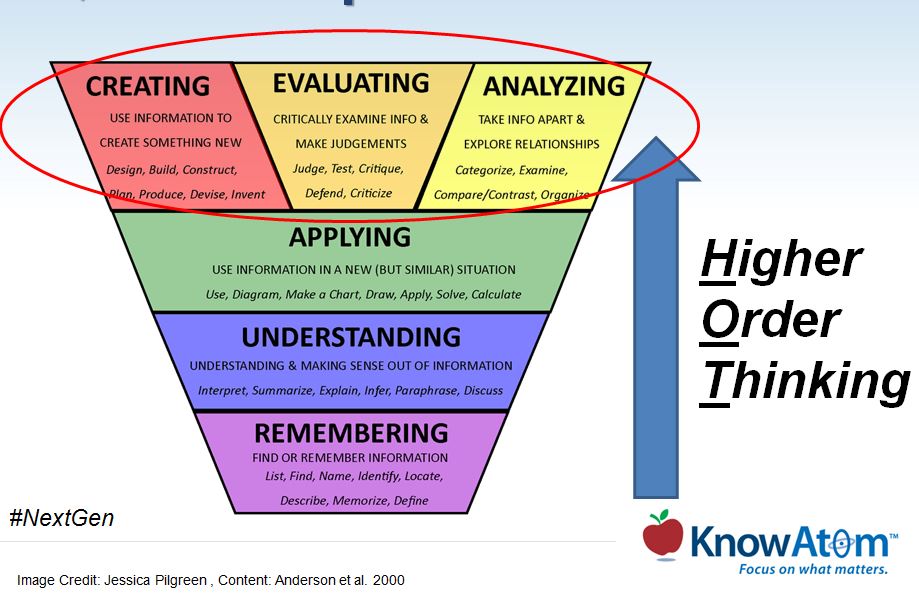
I pull up this diagram because with the next generation science standards, one of the things that’s being talked about right now, a lot is the idea that lower order thinking, just remembering, understanding, applying, isn’t enough. In fact, it’s those higher order thinking skills, creating, evaluating, analyzing, that happen simultaneously that are the direction that states should go in with their Kindergarten through grade 12 curriculum and experiences. Does that make sense? Is that a good direction for K-12? Does CUAUV represent something that’s unique even at a college level in the higher order thinking context?
Lederman: Yeah, I would say that … I mean two views basically represents the creating, evaluating, analyzing aspects of thinking. If you’re creating a project and trying to make it work, which is basically involves all three of those things, whereas in high school class or in the college class even, you definitely do plenty of remembering, understanding, applying.
You can dip into the … Or you can go somewhat far into the creating, evaluating, analyzing thing but you always have to return to lower levels. Whereas, CUAUV represents learning things in entirity, in the context of creating, evaluating, and analyzing in pursuit of the AUV’s end goal.
Vigeant: Thinking about elementary, middle school, high school, and then onto college, we go through a whole of this training for a good chunk of our lives with the idea that we want to do something with that. It sounds like CUAUV is an opportunity, while you’re in school … Maybe some people might do internships, but CUAUV is an opportunity to apply even before an internship and create something and see its performance.
I noticed that, and you mentioned this a bit earlier, the Cornell University Autonomous Underwater Vehicle team is sponsored by a number of national and international STEM companies. Companies like Shell, ExxonMobil, GE, and many others. Why … What’s the connection? Why should these national and international STEM companies who rely on producing STEM innovations invest in your team’s work? What’s the broader hope, I guess, as you all emerge from the team, from the college?
Lederman: I would say that the companies that rely on producing the STEM innovations, there are people producing those innovations, and those people come from colleges where they have gleaned experience in teams like CUAUV. It’s a type of people that CUAUV produces, these people that go through project teams are most capable of producing the innovations that these companies … That are the basis of these companies.
I feel so … Having taken STEM education that CUAUV exemplifies is really important for people who have that education are really important for these companies, in order for them to be successful and to continue to produce innovations.
Vigeant: It sounds like that connection between those higher order thinking skills, creating, evaluating, analyzing, when you can execute those … Whatever you want to call them … Soft skills or whatever, in line with real technical skills, the knowledge of the disciplines themselves. That that’s a real recipe for success when it comes to workforce development, because you’re primed as a people who make innovations or the future innovation makers, for these companies to be trainable but also to deliver on the promise of the companies themselves and their vision and mission.
Lederman: Mm-hmm.
Vigeant: Thinking about that, I guess, for K-12 educators, one of the things that we’re often discussing is to this point many states’ science standards … What those benchmarks are for proficiency at Kindergarten all the way through Grade 12, have been based solely on a student’s ability to memorize and recall facts in most states.
Lederman: Mm-hmm.
Vigeant: Do you think that’s adequate? To give that maybe a little bit more context, there’s this traditional model, that, “memorize and recall structure forms and it’s what you see here.” It’s the idea that there’s all this content, the facts to be known and that’s out there. It has to flow through a teacher who is that content expert who demonstrates the phenomenon, models the facts and explains what things are all about.
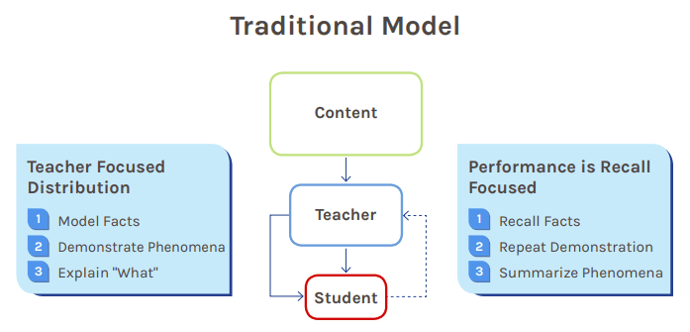
Vigeant: Students, and I think this is what you had described a little bit earlier, the students’ role in that traditional model is to recall the facts, repeat the demonstrations or be able to summarize the phenomenon, to show that they’ve learned something. Does that traditional model, does it fit? Is it adequate?
Lederman: I would say that, the student, in order to really understand material, they have to be able to, I guess, access the concept for themselves. They have to be able to experiment, to learn … They have to be encouraged to learn new things on their own to, I guess, interact directly with the content. I feel as though in order to interest students in the STEM areas, you have to show them that there is room for creativity in STEM, it’s not just a bunch of technical facts, not just a bunch of things you have to memorize. There actually is … They can explore the field. They could potentially contribute to the field themselves.
Vigeant: I want to come back to this in a minute because I want to ask you in terms of the number of students who choose to pursue STEM, does this traditional model play a role in your opinion, but I want to … Before I ask you that question, I want to just bring up that the National Academies of Science and Engineering, along with the National Institute of Health, got together back in 2010, 2011, really redefined what effective science instruction or we can even say STEM instruction is.
I’d like to read that definition and get your thoughts on it. This is the definition here and it represents, I believe, a shift from the kind of image you see on the left to the image you see on the right. The definition is that “Effective instruction capitalizes on students’ early interest and experiences, identifies, and builds on what they know, and provides them with the experiences to engage them in the practices …” or we could say skills, “Of science and sustain their interest.” What do you think of that definition? Does that, especially thinking Kindergarten through grade 12, is that a shift from your experience?
Lederman: Yeah, I’d say that that is a shift, because it basically says that the students have to be able to directly interact with the material themselves. They have to be able to learn about the material themselves. They have to be able to get a sense of what STEM actually is for themselves. I believe that the definition better represents that necessity in education than the idea that the teachers serves as a gateway between the content and the students.
Vigeant: With that in mind, there’s this Next Generation Model of instruction that’s emerged and one that we use for K-12 that replaces this traditional model. It speaks, I think, to many of the points you brought up in our conversation so far. That I guess the elementary, middle school, and high school experience where under a traditional model is much more maybe task and fact oriented and recall oriented.
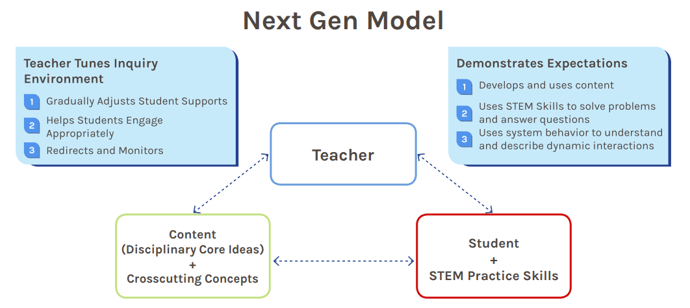
Vigeant: Here the Next Generation Model is really putting the students and those skills together so that it … The skills are actually a tool that the students use to develop and actually use the content or the disciplinary ideas and the systems thinking which is referred to now as cost-cutting contents. The role of that teacher, you described as a gateway under the traditional model, isn’t a gateway anymore. They’re more somebody who’s tuning the environment that a student learns in, whether it’s a Kindergartner, a 5th grader or a 10th grader or someone, and so helping students understand what it is to be a scientist, how to engage appropriately and so on.
What would you say to K-12 educators who might prefer to play the role of an expert explainer and may be more comfortable in a traditional model? What would you say to them? Do you feel this choice may be between traditional and Next Generation or we might say, recall and make some things a little more authentic? Does it have an effect?
Lederman: I would say that the kind of the perspective that the traditional model that the expert creates is that STEM seems, attachment goal’s teams boring basically where a student can’t just have any room to follow their own interests that they don’t feel, so they have room to create on their own which … It turns them away from STEM. I believe that you have to, you need to have direct … I guess you’d try this cross-cutting concepts. The ability for a student to connect directly with the content, for the student to be able to explore on their own. To make sure that this teacher is taught, I guess, before setting up a particular perspective or particular idea of STEM onto the students.
Vigeant: That’s an interesting point, because under a traditional model, the content that students are exposed to is government, by the requirements of the state, but at the same time, it’s really the teacher’s perspective that students get. Would you agree with that?
Lederman: Yeah, I’d say that’s probably pretty accurate.
Vigeant: I guess for society at large and as we wrap up, there’s a great deal of concern nationally about the future of STEM innovation. Because STEM industry could use more qualified graduates, and not just folks with STEM degrees, but folks who have STEM degrees but also are as engaged, as you seem, in problem solving and using those higher order thinking skills. What nationally, these surveys are done, asking students why they didn’t go after a STEM degree, they often cite things like readiness for math courses, pure disinterest or so on. What can educators do to change that? Why do you think so few students leave high school and go after a STEM degree?
Lederman: I would say that the best thing that educators could do to make students interested in STEM is show that the STEM areas involve creativity. They allow the student to explore. They’re not these static areas so you just have to learn and then ignore them. They are fields which involve … They’re very diverse. There’s room for students to make their own contributions, and I feel that if educators made more of that impression to students, more students would be interested in pursuing the STEM degrees.
Vigeant: It sounds like that interest is driven by the opportunity to really interact at some level and create.
Lederman: Mm-hmm.
Vigeant: I’d like to thank you, Josh, for joining us. I’ve learned an awful lot and I feel like you’re a great example of how this K-12 education experience leads up to college choices, but also this whole other dimension of workforce readiness and innovation. I want to thank you for joining us.
Lederman: Thanks for having me. It’s great to be able to give some input.
Vigeant: You’re very welcome, and I’d like to thank everyone who’s joined us for this look at the path to innovation. If you’d like to explore the path to innovation further through the eyes of other STEM experts, please visit knowatom.com/online-events. Thank you for your time, I’m Francis Vigeant. Thanks for joining us.





